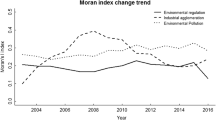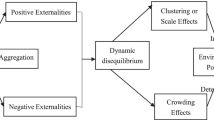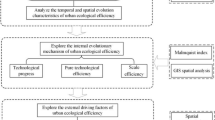Abstract
With the continous advancement of industrialization, the environmental problems among resource-based cities in China are becoming increasingly serious. Therefore, exploring the spatiotemporal evolution characteristics of industrial agglomeration and environmental pollution to understand the interaction mechanism between them is of great significance for the coordinated development of resource-based cities. In this paper, 114 resource-based cities in China are selected as research objects, and data from the period of 2011 to 2020 are used for analysis and research. Location entropy and entropy weight models are used to measure the relevant indicators, and a spatial simultaneous equation model is constructed. The generalized spatial three-stage least squares (GS3SLS) method is used to assess the spatial interactive spillover effects of industrial agglomeration on environmental pollution. The research results show that ① the industrial agglomeration center of China has begun to shift to the junction of Shanxi, Shaanxi, and Inner Mongolia, and the level of environmental pollution has dropped significantly; ② industrial agglomeration promotes environmental pollution, while environmental pollution inhibits industrial agglomeration, and between them, the inhibition effect is more obvious; ③ the level of industrial agglomeration in surrounding cities promotes industrial agglomeration in the region and inhibits environmental pollution, while the level of environmental pollution in surrounding cities inhibits industrial agglomeration in the region and promotes the diffusion of pollution. Thus, the building of a coordinated development system across regions can achieve a win–win situation between industrial development and environmental protection.










Similar content being viewed by others
Data availability
The datasets generated during and/or analyzed during the current study are available from the corresponding author on reasonable request.
References
Ayotamuno JM, Kogbara RB (2007) Response of environmental characteristics to industrialization: a case study of the Onne Oil and Gas Free Zone, Nigeria. J Food Agric Environ 5(1):288
Aslam B, Hu J, Hafeez M, Ma D, AlGarni TS, Saeed M et al (2021) Applying environmental Kuznets curve framework to assess the nexus of industry, globalization, and CO2 emission. Environ Technol Innov 21:101377. https://doi.org/10.1016/j.eti.2021.101377
Astuti T (2015) The role of manufacturing industrial activity in the environmental pollution in South Sulawesi. J Econ Behav Stud 7(2 (J)):116–123. https://doi.org/10.22610/jebs.v7i2(J).569
Ahmad M, Khan Z, Anser MK, Jabeen G (2021) Do rural-urban migration and industrial agglomeration mitigate the environmental degradation across China's regional development levels? Sustain Prod Consump 27:679–697. https://doi.org/10.1016/j.spc.2021.01.038
Brimblecombe P (1978) Air pollution in industrializing England. J Air Pollut Cont Assoc 28(2):115–118. https://doi.org/10.1080/00022470.1978.10470577
Bao H, Shan L, Wang Y, Jiang Y, Lee C, Cui X (2021) How does local real estate investment influence neighborhood PM2. 5 concentrations? A spatial econometric analysis. Land. 10(5):518. https://doi.org/10.3390/land10050518
Cheng Z, Li X, Wang M (2021) Resource curse and green economic growth. Res Policy 74:102325
Chertow MR, Ashton WS, Espinosa JC (2008) Industrial symbiosis in Puerto Rico: environmentally related agglomeration economies. Reg Stud 42(10):1299–1312. https://doi.org/10.1080/00343400701874123
Cheng Z, Jin W (2022) Agglomeration economy and the growth of green total-factor productivity in Chinese industry. Socio Econ Plan Sci 83:101003
Chen Q, Chen S, Shi C, Pang Q, Li A (2021) Evaluation of agricultural investment environment in countries around the Black Sea under the background of The Belt and Road. In Natural Resources Forum (Vol. 45, No. 4, pp. 464-483). Oxford, UK: Blackwell Publishing Ltd. doi:https://doi.org/10.1111/1477-8947.12236
Fagbohunka A (2015) Industrial agglomeration and environmental problems severity perception, in the Lagos Region Nigeria. J Natl Sci Res 5(15):28–34. https://doi.org/10.5897/AJBM2015.7801
Hettige H, Mani M, Wheeler D (2000) Industrial pollution in economic development: the environmental Kuznets curve revisited. J Dev Econ 62(2):445–476. https://doi.org/10.1016/S0304-3878(00)00092-4
Hu ZQ, Miao JM, Miao CH (2018) Spatial characteristics and econometric test of industrial agglomeration and pollutant emissions in China. Sci Geogr Sin 38(2):168–176. https://doi.org/10.13249/j.cnki.sgs.2018.02.002 (in Chinese)
Jin CY, Wu AB (2017) An empirical study on the nonlinear effects of industrial economic structure and economic growth on environmental pollution. China Popul Resour Environ 27(10):64–73. https://doi.org/10.12062/cpre.20170519 (in Chinese)
Jiao S, Wu SS, Han ZW, Peng K (2022) Spatial-temporal evolution and correlation mechanism of industry agglomeration and water pollution degree in “One Lake and Four Rivers” basins of Hunan. Econ Geogr 42(04):132–140. https://doi.org/10.15957/j.cnki.jjdl.2022.04.015 (in Chinese)
Li YH (2018) Study on spatial distribution and control of industrial pollution in China. Economist. (09), 59-65. https://doi.org/10.16158/j.cnki.51-1312/f.2018.09.007 (in Chinese)
Li XL (2014) An empirical analysis based on marketization, industrial agglomeration and environmental pollution. Stat Res 31(08):39–45. https://doi.org/10.19343/j.cnki.11-1302/c.2014.08.006 (in Chinese)
Lanjouw JO, Mody A (1996) Innovation and the international diffusion of environmentally responsive technology. Res Policy 25(4):549–571. https://doi.org/10.1016/0048-7333(95)00853-5
Liu SX, Zhu YM, Pei Y (2021) The spillover effect of industrial agglomeration on environmental pollution under the restraint of environmental regulation. Ecological Economy. 37(06), 172-177 + 192(in Chinese).
Mottaeva A (2017) Methodological approaches to identification of clusters in regional economy system. In MATEC Web of Conferences (Vol. 106, p. 08071). EDP Sciences. doi:https://doi.org/10.1051/matecconf/201710608071.
Popov O, Iatsyshyn A, Kovach V, Artemchuk V, Kameneva I, Taraduda D et al (2020) Risk assessment for the population of Kyiv, Ukraine as a result of atmospheric air pollution. J Health Pollut 10(25). https://doi.org/10.5696/2156-9614-10.25.200303
Rudenko D, Skripnuk D (2016) Environmental Kuznets curve: the case of arctic Russian regions. Intl Multidisc Sci GeoConference: SGEM 3:209–216
Rhoades SA (1993) The herfindahl-hirschman index. Fed Reserv Bull 79:188
Sun Y, Zhou Q, Xie X, Liu R (2010) Spatial, sources and risk assessment of heavy metal contamination of urban soils in typical regions of Shenyang China. J Hazard Mater 174(1-3):455–462. https://doi.org/10.1016/j.jhazmat.2009.09.074
Terrell GR, Scott DW (1992) Variable kernel density estimation. The Annals of Statistics. 1236-1265. https://www.jstor.org/stable/2242011. Accessed 21 Sept 2022
Verhoef ET, Nijkamp P (2002) Externalities in urban sustainability: environmental versus localization-type agglomeration externalities in a general spatial equilibrium model of a single-sector monocentric industrial city. Ecol Econ 40(2):157–179. https://doi.org/10.1016/S0921-8009(01)00253-1
Wu K, You K, Ren H, Gan L (2022) The impact of industrial agglomeration on ecological efficiency: an empirical analysis based on 244 Chinese cities. Environ Impact Assess Rev 96:106841. https://doi.org/10.1016/j.eiar.2022.106841
Wu H (2022) Threshold effect of collaborative agglomeration of internet and high-tech industry on green innovation. In International Conference on Forthcoming Networks and Sustainability in the IoT Era (pp. 249-256). Springer, Cham. doi:https://doi.org/10.1007/978-3-030-99616-1_33
Xing M, Luo F (2018) Comparative study on the optimization path of industrial value chain in China’s resource-based cities. Sustainability. 10(5):1338. https://doi.org/10.3390/su10051338
Xiao ZY, Li HH, Sun L (2022) Population and industrial agglomeration’s spatial impact on production & consumption pollution and overflow. Resour Environ Yangtze Basin 31(04):851–861 (in Chinese)
Yang YT (2022) Study on the impact of industrial agglomeration on environmental pollution. Co-Operative Economy & Science. (16), 4-6. https://doi.org/10.13665/j.cnki.hzjjykj.2022.16.073 (in Chinese).
You DM, Li LN (2022) Environmental regulation intensity, frontier technology gap and firms’ green technology innovation. Soft Science 36(08):108–114. https://doi.org/10.13956/j.ss.1001-8409.2022.08.15 (in Chinese)
Zhu Y, Xia Y (2019) Industrial agglomeration and environmental pollution: evidence from China under New Urbanization. Energy Environ 30(6):1010–1026. https://doi.org/10.1177/0958305X1880278
Zhou K, Wang Q, Tang J (2022) Evolutionary game analysis of environmental pollution control under the government regulation. Sci Rep 12(1):1–16
Zhou HL, Jiang YJ (2021) Interaction and spatial spillover between tourism attraction and traffic accessibility. J East China Univ Technol (Social Science) 40(6):559–565. https://doi.org/10.3969/j.issn.1674-3512.2021.06.005 (in Chinese)
Zhang J, Zhang K, Zhao F (2020) Spatial effects of economic growth, energy consumption and environmental pollution in the provinces of China—an empirical study of a spatial econometrics model. Sustain Dev 28(4):868–879. https://doi.org/10.1002/sd.2042
Funding
This work was supported by the National Social Science Fund of China (No. 22BTJ071).
Author information
Authors and Affiliations
Contributions
All authors contributed to the study conception and design. Material preparation, data collection, and analysis were performed by Feng Zhao, Yi Sun, and Jie Zhang. The first draft of the manuscript was written by Feng Zhao. Visualization and software were performed by Yi Sun. Funding acquisition was performed by Jie Zhang, and all authors commented on previous versions of the manuscript. All authors read and approved the final manuscript.
Corresponding author
Ethics declarations
Ethical approval
Not applicable.
Consent to participate
Not applicable.
Consent for publication
Not applicable.
Competing interests
The authors declare no competing interests.
Additional information
Responsible Editor: Philippe Garrigues
Publisher’s note
Springer Nature remains neutral with regard to jurisdictional claims in published maps and institutional affiliations.
Rights and permissions
Springer Nature or its licensor (e.g. a society or other partner) holds exclusive rights to this article under a publishing agreement with the author(s) or other rightsholder(s); author self-archiving of the accepted manuscript version of this article is solely governed by the terms of such publishing agreement and applicable law.
About this article
Cite this article
Zhao, F., Sun, Y. & Zhang, J. Does industrial agglomeration and environmental pollution have a spatial spillover effect?: taking panel data of resource-based cities in China as an example. Environ Sci Pollut Res 30, 76829–76841 (2023). https://doi.org/10.1007/s11356-023-27852-y
Received:
Accepted:
Published:
Issue Date:
DOI: https://doi.org/10.1007/s11356-023-27852-y




